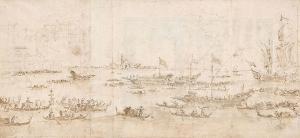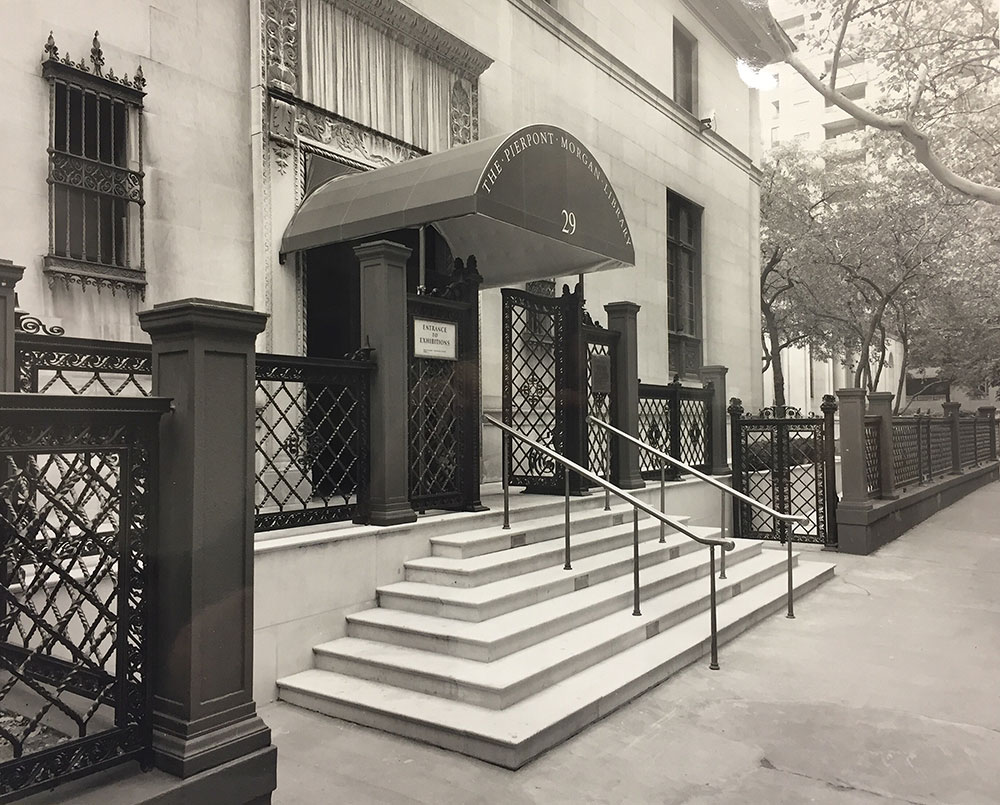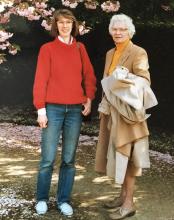Pierpont Morgan’s librarian, Belle da Costa Greene (1879–1950), shepherded the banker’s collections beginning in 1905 and continued doing so for many years after his death in 1913, working alongside his son and eventually serving as the museum’s first director from 1928 until her retirement in 1949. After the Morgan opened its doors as a public institution, the drawings collection—established by Morgan in 1909—continued to grow through gifts from the Morgan family and from a small number of patrons, as well as through select purchases. Soon Greene realized the need to hire a professionally trained curatorial staff to manage the wide-ranging collections of the Morgan. Felice Stampfle (1913–2000) was appointed the first curator of the collection of drawings and prints in 1945. She studied art history at Washington University in St. Louis, graduating in 1942, and had learned connoisseurship in Paul Sach’s famous class “Museum Work and Museum Problems” at Harvard University (1943–45). With Stampfle’s arrival, after a more than thirty‐year hiatus, the acquisition of drawings in earnest began again, not in one grand purchase as with Morgan’s acquisition of the collection assembled by Fairfax Murray, but through thoughtful management of a limited budget, with select annual purchases and the occasional largesse of important gifts and bequests.
During her nearly forty years leading the department, Stampfle took seriously her responsibility to the entire collection and bought across schools and centuries as the opportunities arose. She had modest funds, but also a close circle of supporters and relatively few competitors, as the Morgan’s drawings department was one of the first founded at an American museum before the 1960s. Many of Stampfle’s acquisitions now have a secure place among the “greatest hits” of the drawings department. To the 1,500 drawings in the Fairfax Murray collection at the library when she started, Stampfle added 4,759 sheets through purchase, gift, and bequest. In the wake of her retirement in 1984, the Morgan received hundreds more drawings from donors with whom she worked closely for decades such as Rudolf and Lore Heinemann, Janos Scholz, and Eugene V. Thaw. It is Felice Stampfle who was responsible for ensuring the Morgan’s collection remained among the foremost in America after Morgan’s initial purchase.

Fig. 5. Francesco Guardi, The Bucintoro off S. Niccolo di Lido, acc. no. 1947.2, one of Stampfle’s first acquisitions, of which she always remained especially proud.
Stampfle led an ambitious exhibition program that included shows and publications devoted to Giovanni Battista Piranesi (1949), drawings and prints by Albrecht Durer (1955), drawings and oil sketches by Peter Paul Rubens from American collections (1956, with Agnes Mongan at the Fogg Art Museum), and Rembrandt drawings in American collections (1960, with Egbert Haverkamp-Begemann). Some of her most successful projects were born of close collaboration with fellow scholars and friends, such as Carlos van Hasselt at the Fondation Custodia, with whom she produced Rubens and Rembrandt in their Century (1979), and Jacob Bean at the Metropolitan Museum of Art, with whom she produced a series of projects devoted to Italian drawings in New York collections (1965, 1967).
In late 1961, at the instigation of the library’s then director, Frederick B. Adams, Jr. (1910–2001), Stampfle founded the Master Drawings Association, Inc., a not-for-profit organization dedicated to disseminating knowledge in the field of Western draftsmanship since the Renaissance. The association issued an academic quarterly, Master Drawings, which was launched in 1963 with Stampfle as editor. She continued to edit the journal until 1983. Her skills as an art historian and an editor ensured the journal set a high standard for scholarship and became the leading publication in the field.
Stampfle’s commitment to scholarship is evident in the robust exhibition, publication, and programming schedule she maintained for decades. But it also was readily apparent in a situation every curator dreads: in the 1970s, suspicion arose over a drawing she had purchased in 1954. Her colleague at the National Gallery of Art, Konrad Oberhuber, realized that an early Renaissance sheet he had recently acquired seemed to have a lot in common with the Morgan’s drawing and that they were probably forgeries by the same hand. As the process of investigating these drawings unfolded, Stampfle was curious, open, and eager to sort out the problem, working with Oberhuber and others to unmask the forger, Eric Hebborn. This clear-eyed, sensible attitude was typical of Stampfle’s approach to her work.
By 1984 Stampfle stepped back from her daily duties at the Morgan and turned her attention to completing her catalogue of the museum’s early Netherlandish and Flemish drawings. Her 662-page tome appeared in 1991 and remains the standard source on these works. Not one to rest on her laurels, she had already begun work on the next volume, a catalogue of the library’s Dutch drawings, an endeavor that was completed in 2006 by Jane Shoaf Turner. Turner was hired by Stampfle as a curatorial assistant in 1978 and became an assistant curator before her departure in 1984 to London, where she was soon appointed editor of the Dictionary of Art. Turner would also succeed her mentor as editor of Master Drawings in 2005.
Stampfle was described by contemporaries as a formidable presence with a serious and unflappable demeanor. She was also a leader in a male-dominated field. Her bearing was formal—she was always addressed, even by her staff, as Miss Stampfle. She wrote her texts in longhand on legal pads and edited journal and catalogue manuscripts scrupulously. Over the course of my years at the Morgan, I have sorted through boxes of her papers and deciphered her cursive script for colleagues and visitors. Through this exposure to her work, I continue to be impressed by Stampfle’s diligence, care, thoughtful management, discipline, and tireless work ethic throughout her tenure. Her legacy is not only her scholarship and high standards and the many works she brought into the collection, but it is also the example of a career characterized by steady determination, fruitful collaboration, and an indomitable spirit.
Jennifer Tonkovich
Eugene and Clare Thaw Curator
The Morgan Library & Museum







